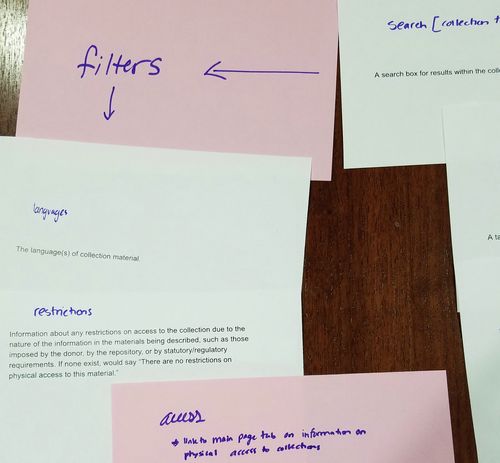Table of Contents
...
Findings and Recommendations
Items of Importance
Summary:
A majority of participants indicated that the most important component for them was the abstract. Verbally they explained that this seemed like a quick way of learning more about the collection and determining whether or not they should spend more time learning about it. Most users chose to place the abstract such that it was one of the first items encountered on the page, offering immediate context for their encounter with the collection. The longer scope and contents note was something participants also thought was important, but less-so and they tended to want to “opt in” to more information about the collection and did not want it presented by default.
...
Several participants also mentioned that they would prioritize example photographs of the collection and that images of sample items in the collection would be helpful.
Recommendations
Maintain abstracts on collection pages in an always open (not collapsed) state and continue to provide abstracts on the collection search page. Add abstracts to the search results.
...
Information hierarchies and themes
Summary
Participants overwhelmingly moved several elements out of the main page, creating a second tier of information that would not draw their attention away from information and functions they identified as more important for their work in the system. 5 of 6 users omitted processing information, acquisition information, and the bioghist from the main collection page. Processing and acquisition information are more administrative element in nature and were not significant for a majority of participants in a majority of their work; participants wanted this to be reflected on the page so that these elements were not treated as of equal importance to information they required more immediate access to.
...
Almost every user also sorted the page elements into two or three different themes, aligned n distinct columns. By using columns or nested links, several users seemed to develop separate content and use themes. Content included things such as Abstract, Bioghist, Scope and Contents, and the Search within the Collection, while use included Citations, Access and Use Restrictions, and How to Access the Collection. Arrangement and scope were usually grouped together.
Recommendations
Bundle administrative data such as processing and acquisition information and present it at a lower level on the page.
...
Give users a clearer sense of what is about the collection in a broadly descriptive way and what the collection is in terms of its contents. This may be accomplished through labeling the columns to create clarity for users about the function of the elements which now occupy the majority of the collection page space and providing a label for the Contents and Arrangement sidebar that resonates and makes more immediate sense to users. Rebalancing of the page that does not relate the contents to a comparatively small sidebar. Featuring search, both within the collection and of other collections in this section could also be relevant to users.
Added Functions
Summary
The most often suggested addition to the collection page’s current elements was for a feature with instructions on how to access the collection. Without any prompting, 5 out of 6 participants added this feature, indicating that they would want to have details on access made very clear on the collection page; they did not want to hunt down this information elsewhere on the site.
...
Several participants also hoped to make the terms used in the description of arrangement (date, alphabetical, subject matter) a function with the ability to sort or filter the collection. They also wanted buttons to create citations of collections and, importantly, components within the collection.
Recommendations
Add a component that will describe how patrons can access the collection. This may be link or button that will display repository-specified generic language about policies and procedures for access. This function is different from a request button to fulfill because it is not just about getting access to the material, it is about understanding the process, procedures, and policies that will govern access.
...
For future development, it may be useful to think about ways that users can interact with the data in ways that offer them more personal and directly useful ways so they can sort and resort, filter, and expand.
Submitted by Emilie Hardman, October 28, 2016.
